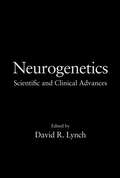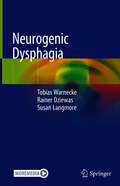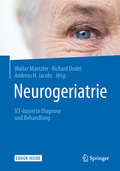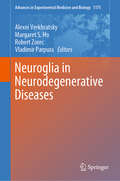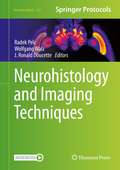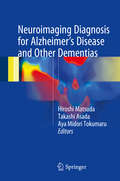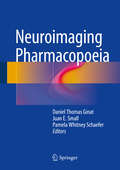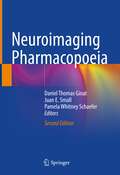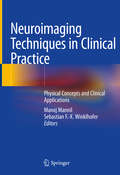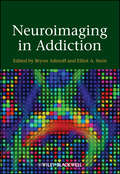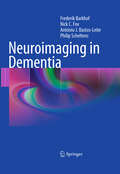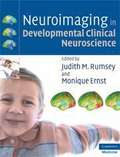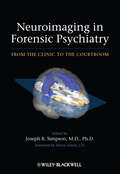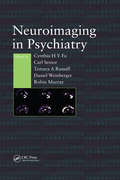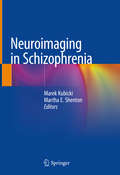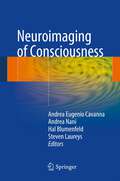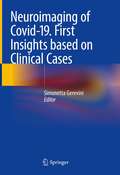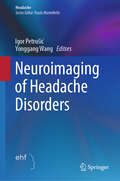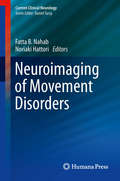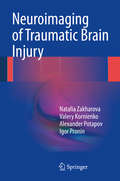- Table View
- List View
Neurogenetics: A Guide for Clinicians
by Nicholas W. WoodProgress in genetic knowledge is profoundly affecting medical practice, and no clinical specialty has more diseases associated with genetic mutations than neurology. As a more complete picture of the genes which give rise to neurological disease is obtained, trainee and practising neurologists need a guide to basic principles and the more important clinical entities with a genetic component. It is against this background that Neurogenetics: A Guide for Clinicians has been written. The book opens with coverage of genetic testing and counselling. Subsequent chapters discuss genetic factors for all the major neurological diseases, including epilepsy, Alzheimer's disease, Parkinsonism and muscular dystrophies. No book in this field can hope to be fully up to date with the latest research; rather this work provides a framework on which to add new genetic discoveries. Neurogenetics: A Guide for Clinicians provides a synoptic overview for neurologists, medical geneticists and scientists working in the field.
Neurogenetics: Current Topics in Cellular and Developmental Neurobiology (Learning Materials in Biosciences)
by Boris EggerThis textbook provides students with knowledge of neurogenetics, neurogenesis, neuronal specification and function, neuronal networks, learning and memory formation, brain evolution, and neurodegenerative diseases.Students are introduced to topics of classical developmental genetics as well as modern molecular and neurogenetic methods. Using a wealth of examples from current research, the textbook takes a strong applied approach. Using animal models such as Drosophila melanogaster and Caenorhabditis elegans as well as mammalian systems, the interrelationships between genes, neurons, nervous systems, and behaviour under normal and pathological conditions are illustrated. The textbook aims encourage students to address biological questions in neurogenetics and to think about the design of their own experiments. It targets primarily master and graduate students in neurobiology, but is also a valuable teaching tool for instructors in these fields.
Neurogenetics: Scientific and Clinical Advances (Neurological Disease and Therapy)
by David R. LynchStanding at the forefront of neurogenetic medicine, this reference supplies the tools and information required by clinicians to become familiar with modern neurogenetic approaches and apply the data gleaned from these technologies to the diagnosis and treatment of neurogenetic disorders, as well as traditionally non-genetic conditions such as Parki
Neurogenic Dysphagia
by Tobias Warnecke Rainer Dziewas Susan LangmoreThis book is a clinical manual that covers the whole spectrum of swallowing and its disorders. It starts with physiology of swallowing, pathophysiology of disordered deglutition, diagnostic methods (clinical and instrumental) and ends with an in-depth’s and up-to-date presentation of current treatment options. The clinically most relevant topics of dysphagia management on the stroke unit and the intensive care unit are dealt with in separate chapters. Also the closely intertwined issue of nutritional management is specifically addressed. Most importantly, the book covers all obligatory topics of the Flexible Endoscopic Evaluation of Swallowing (FEES)-curriculum, an educational initiative that started in Germany in 2014 and is currently being extended to other European and non-European countries. The book is richly illustrated and an online video section provides a number of typical patient cases. FEES is probably the most commonly chosen method for the objective assessment of swallowing and its disorders. It is used in stroke units, intensive care facilities, geriatric wards but also in rehabilitation clinics and within dedicated outpatient services. This book on neurogenic dysphagia therefore addresses a wide range of different medical disciplines, such as neurologists, geriatricians, intensive care physicians, rehabilitation physicians, gastroenterologists, otolaryngologists, phoniatrists and also speech-language pathologists.
Neurogeriatrie: ICF-basierte Diagnose und Behandlung
by John E. Morley Jürgen Bauer Walter Maetzler Richard Dodel Andreas H. Jacobs Günther DeuschlIn diesem Buch werden die Funktionseinschränkungen des Alters beschrieben, die führend durch Erkrankungen des Nervensystems bedingt sind. Basierend auf der Internationalen Klassifikation der Funktionsfähigkeit, Behinderung und Gesundheit (ICF) werden die einzelnen Themen in Bezug auf Diagnose und Therapie dargestellt. Der Behandler wird so geschult, den Fokus der Arbeits- und Denkweise der Altersmedizin nicht primär auf die Grunderkrankung, sondern auf die Funktionseinbuße zu lenken und damit das Nutzen-Risiko-Verhältnis einer medizinischen Maßnahme sorgfältig abzuwägen
Neuroglia in Neurodegenerative Diseases (Advances in Experimental Medicine and Biology #1175)
by Vladimir Parpura Alexei Verkhratsky Margaret S. Ho Robert ZorecThis book provides a comprehensive overview of the role of neuroglia in neurodegenerative diseases. Neuroglia are the most abundant cells in the nervous system and consist of several distinct cell types, such as astrocytes, oligodendrocytes,and microglia. Accumulating evidence suggests that neuroglia participate in the neurodegenerative process, and as such are essential players in a variety of diseases, including Alzheimer’s, Parkinson’s, and Huntington’s. Intended for researchers and students, the book presents recent advances concerning the biology of neuroglia as well as their interaction with neurons during disease progression. In addition, to highlight the function of neuroglia in different types of neurodegenerative disease, it also discusses their mechanisms and effects on protecting or damaging neurons.
Neurohistology and Imaging Techniques (Neuromethods #153)
by Wolfgang Walz Radek Pelc J. Ronald DoucetteThis volume explores major light microscopic imaging modalities that can be used to view nervous tissue, and discusses the steps needed to use each of them, and ways to interpret the data. The chapters in this book cover topics such as atlasing of insect brain; neuroanatomical tracing through fluorochrome expression; fluorescent probes for amyloids; or optical clearing for ultramicroscopy of GFP-expressing tissues. In the Neuromethods series style, chapters include the kind of detail and key advice from the specialists needed to get successful results in your laboratory.Authoritative and cutting-edge, Neurohistology and Imaging Techniques is a valuable resource for both expert and novice users of major light microscopic imaging techniques, and those interested in exploring alternate imaging tools.
Neurohospitalist Medicine
by S. Andrew Josephson W. David Freeman David J. LikoskyOver the past decade, the hospitalist model has become a dominant system for the delivery of inpatient care. Forces such as national mandates to improve safety and quality, and intense pressure to safely reduce length of hospital stays, are now exerting pressure on neurologists. To meet these challenges, a new neurohospitalist model is emerging. This is the first authoritative text to detail the advances and strategies for treating neurologic disease in a hospital setting. It includes chapters on specific acute neurologic diseases including stroke, epilepsy, neuromuscular disease and traumatic brain injury and also addresses common reasons for neurologic consultation in the hospital including encephalopathy, electrolyte disturbances and neurologic complications of pregnancy. Ethical and structural issues commonly encountered in neurologic inpatients are also addressed. This will be a key resource for any clinician or trainee caring for neurologic patients in the hospital including practising neurologists, internists and trainees across multiple subspecialities.
Neuroimaging Diagnosis for Alzheimer's Disease and Other Dementias
by Hiroshi Matsuda Takashi Asada Aya Midori TokumaruThis book describes the latest modalities such as tau PET imaging for diagnosis of Alzheimer's disease and other dementias, and also provides information on handling and analyzing imaging data that is not found in other books. In addition, it introduces routine imaging studies in the management of dementia in Japan. The prevalence of dementia has increased over the past few decades, either because of greater awareness and more accurate diagnosis, or because increased longevity has created a larger population of the elderly, the age group most commonly affected. Although only clinical assessment can lead to a diagnosis of dementia, neuroimaging in dementia is recommended by most clinical guidelines, and its adjunct role has traditionally been to exclude a mass lesion rather than to support a specific diagnosis. Neuroimaging may be also helpful for developing new strategies to achieve diagnoses as early as possible for therapies aimed at slowing the progression of neurodegenerative diseases manifesting dementia. Under these conditions, all clinicians and researchers who are involved in neuroimaging for dementia should decide which patients to scan, when imaging patients is most useful, which modality to use, how to handle imaging data from many institutions, and which analytical tool to use. This edition comprises contributions from leading Japanese experts in their fields.
Neuroimaging Pharmacopoeia
by Daniel Thomas Ginat Juan E. Small Pamela Whitney SchaeferThis book reviews the imaging features associated with selected classes of pharmaceuticals and drugs on brain, head and neck, and spine and explains the implications of the imaging findings for the neuroradiologist and the clinician. Some agents produce characteristic abnormalities with distinctive imaging features, while others have a spectrum of manifestations on imaging. Still further agents produce rather nonspecific changes on imaging, requiring a differential diagnosis. In this book, informative cases are depicted by rich images, with concise accompanying explanatory text that reviews the class of agent and the mechanism of action and discusses image interpretation and its significance.
Neuroimaging Pharmacopoeia
by Daniel Thomas Ginat Juan E. Small Pamela Whitney SchaeferThis book, now in a revised and updated second edition, reviews the imaging-relevant features of selected classes of pharmaceuticals and drugs regarding CNS and head and neck images. The agents discussed belong to classes like Drugs and Alcohol; Contrast Agents; Chemotherapy; Immunotherapy; Antibiotics, Antiviral Agents, and Vaccines; Antiepilectic and Antipsychotic Agents; and Hematologic Agents, each of which is addressed in a separate chapter. The book’s closing part addresses agents from various other classes. For each class, concise texts and rich images review and illustrate the mechanism of action. All chapters from the previous edition have been extensively updated, and new chapters on certain pharmaceuticals have been added. Highlighting the implications of these agents for imaging findings, the book offers an excellent resource for neuroradiologists and clinicians alike.
Neuroimaging Techniques in Clinical Practice: Physical Concepts and Clinical Applications
by Manoj Mannil Sebastian F.-X. WinklhoferThis book provides a concise overview of emerging technologies in the field of modern neuroimaging. Fundamental principles of the main imaging modalities are described as well as advanced imaging techniqes including diffusion weighted imaging, perfusion imaging, arterial spin labeling, diffusion tensor imaging, intravoxel incoherent motion, MR spectroscopy, functional MRI, and artificial intelligence. The physical concepts underlying each imaging technique are carefully and clearly explained in a way suited to a medical audience without prior technical knowledge. In addition, the clinical applications of the various techniques are described with the aid of illustrative clinical examples. Helpful background information is also presented on the core principles of MRI and the evolution of neuroimaging, and important references to current medical research are highlighted. The book will meet the needs of a range of non-technological professionals with an interest in advanced neuroimaging, including radiology researchers and clinicians in the fields of neurology, neurosurgery, and psychiatry.
Neuroimaging in Addiction
by Elliot A. Stein Bryon AdinoffNeuroimaging in Addiction presents an up-to-date, comprehensive review of the functional and structural imaging human studies that have greatly advanced our understanding of this complex disorder. Approaching addiction from a conceptual rather than a substance-specific perspective, this book integrates broad neuropsychological constructs that consider addiction as a neuroplastic process with genetic, developmental, and substance-induced contributions.The internationally recognized contributors to this volume are leaders in clinical imaging with expertise that spans the addiction spectrum.Following a general introduction, an overview of neural circuitry and modern non-invasive imaging techniques provides the framework for subsequent chapters on reward salience, craving, stress, impulsivity and cognition. Additional topics include the use of neuroimaging for the assessment of acute drug effects, drug-induced neurotoxicity, non-substance addictive behaviors, and the application of imaging genetics to identify unique intermediate phenotypes. The book concludes with an exploration of the future promise for functional imaging as guide to the diagnosis and treatment of addictive disorders.Scientists and clinicians will find the material in this volume invaluable in their work towards understanding the addicted brain, with the overall goal of improved prevention and treatment outcomes for patients.Features a Foreword by Edythe London, Director of the Center for Addictive Behaviors, University of California at Los Angeles.
Neuroimaging in Dementia
by Philip Scheltens Frederik Barkhof António J. Bastos-Leite Nick C. FoxThis up-to-date, superbly illustrated book is a practical guide to the effective use of neuroimaging in the patient with cognitive decline. It sets out the key clinical and imaging features of the various causes of dementia and directs the reader from clinical presentation to neuroimaging and on to an accurate diagnosis whenever possible. After an introductory chapter on the clinical background, the available "toolbox" of structural and functional neuroimaging techniques is reviewed in detail, including CT, MRI and advanced MR techniques, SPECT and PET, and image analysis methods. The imaging findings in normal ageing are then discussed, followed by a series of chapters that carefully present and analyze the key findings in patients with dementias. Throughout, a practical approach is adopted, geared specifically to the needs of clinicians (neurologists, radiologists, psychiatrists, geriatricians) working in the field of dementia, for whom this book will prove an invaluable resource.
Neuroimaging in Developmental Clinical Neuroscience
by Judith M. Rumsey Monique Ernst Husseini K. ManjiModern neuroimaging offers tremendous opportunities for gaining insights into normative development and a wide array of developmental neuropsychiatric disorders. Focusing on ontogeny, this text covers basic processes involved in both healthy and atypical maturation, and also addresses the range of neuroimaging techniques most widely used for studying children. This book will enable you to understand normative structural and functional brain maturation and the mechanisms underlying basic developmental processes; become familiar with current knowledge and hypotheses concerning the neural bases of developmental neuropsychiatric disorders; and learn about neuroimaging techniques, including their unique strengths and limitations. Coverage includes normal developmental processes, atypical processing in developmental neuropsychiatric disorders, ethical issues, neuroimaging techniques and their integration with psychopharmacologic and molecular genetic research approaches, and future directions. This comprehensive volume is an essential resource for neurologists, neuropsychologists, psychiatrists, pediatricians, and radiologists concerned with normal development and developmental neuropsychiatric disorders.
Neuroimaging in Forensic Psychiatry
by Henry Greely Joseph R. SimpsonThis important volume is the first to address the use of neuroimaging in civil and criminal forensic contexts and to include discussion of prior precedents and court decisions. Equally useful for practicing psychiatrists and psychologists, it reviews both the legal and ethical consideraitons of neuroimaging.
Neuroimaging in Forensic Psychiatry: From the Clinic to the Courtroom
by Joseph R. SimpsonThis important volume is the first to address the use of neuroimaging in civil and criminal forensic contexts and to include discussion of prior precedents and court decisions. Equally useful for practicing psychiatrists and psychologists, it reviews both the legal and ethical consideraitons of neuroimaging.
Neuroimaging in Psychiatry
by Carl Senior Cynthia H Y Fu Tamara A Russell Daniel Weinberger Robin MurrayNew neuroimaging techniques are developing at a break neck pace-every academic journal contains glossy pictures of brain activity corresponding to a particular task emblazoned in glorious technicolor. Discoveries about brain function in psychiatric disorders have been made at an equally rapid rate. However, most books on the subject have been writt
Neuroimaging in Schizophrenia
by Martha E. Shenton Marek KubickiThis comprehensive book explains the importance of imaging techniques in exploring and understanding the role of brain abnormalities in schizophrenia. The findings obtained using individual imaging modalities and their biological interpretation are reviewed in detail, and updates are provided on methodology, testable hypotheses, limitations, and new directions for research. The coverage also includes important recent applications of neuroimaging to schizophrenia, for example in relation to non-pharmacological interventions, brain development, genetics, and prediction of treatment response and outcome. Written by world renowned experts in the field, the book will be invaluable to all who wish to learn about the newest and most important developments in neuroimaging research in schizophrenia, how these developments relate to the last 30 years of research, and how they can be leveraged to bring us closer to a cure for this devastating disorder. Neuroimaging in Schizophrenia will assist clinicians in navigating what is an extremely complex field and will be a source of insight and stimulation for researchers.
Neuroimaging of Consciousness
by Steven Laureys Andrea Eugenio Cavanna Andrea Nani Hal BlumenfeldWithin the field of neuroscience, the past few decades have witnessed an exponential growth of research into the brain mechanisms underlying both normal and pathological states of consciousness in humans. The development of sophisticated imaging techniques to visualize and map brain activity in vivo has opened new avenues in our understanding of the pathological processes involved in common neuropsychiatric disorders affecting consciousness, such as epilepsy, coma, vegetative states, dissociative disorders, and dementia. This book presents the state of the art in neuroimaging exploration of the brain correlates of the alterations in consciousness across these conditions, with a particular focus on the potential applications for diagnosis and management. Although the book has a practical approach and is primarily targeted at neurologists, neuroradiologists, and psychiatrists, it will also serve as an essential reference for a wide range of researchers and health care professionals.
Neuroimaging of Covid-19. First Insights based on Clinical Cases
by Simonetta GereviniThis book presents the variability of the effects of Covid-19 on the nervous system (NS), with the purpose to update content and images based on improved scientific evidence. Current available data show that involvement of the NS is frequent in patients with SARS-CoV-2 infection. The most common neurologic syndromes include cerebrovascular disorders, encephalopathies, inflammatory Central Nervous System (CNS) syndromes, peripheral neurologic disorders, psychiatric disorders. The pathophysiology of neurological manifestations is far from being understood. They can be coincidental, common complications of severe viral infection, or direct consequence of the viral infection either via indirect para-infective mechanisms or direct viral penetration of NS. Experimental animal models had previously demonstrated the neuroinvasive potential of SARS-CoV and the detection of viral particles in special structures such as the thalamus, nucleus ambiguous and nucleus of the solitary tract, suggesting that CNS invasion can contribute significantly to the severe outcome not only through direct damage to neurological structures, but also through a potential detrimental effect on cardiorespiratory responses. Up to now, the detection of SARS-CoV-2 RNA in the cerebrospinal fluid of COVID-19 patients has been reported occasionally and conclusive pathological demonstration of the virus in the CNS is lacking. In this scenario, the role of neuroimaging is fundamental. These considerations highlight the urgent need to better clarify the neurotropic potential of the SARS-CoV-2 virus, and to verify on human autoptic tissue the mechanisms demonstrated in the experimental animal model in order to develop potential strategies to prevent CNS invasion and to adapt treatment protocols based on neurological involvement. CT scan is useful to detect large hemorrhage and ischemic lesions, that have been reported in Covid-19 patients, but lacks identifying other possible neurological complications, such as microhemorrhage or encephalitis. MRI could overcome these limitations; in particular the use of specific sequences may reveal microvascular lesions that can occur during the disease course, according to the described pathogenesis. This book will be an invaluable tool for neuroradiologists, radiologists, neurologists, and all physicians involved in the pandemic.
Neuroimaging of Headache Disorders (Headache)
by Igor Petrušić Yonggang WangThis book offers a comprehensive overview of structural and functional neuroimaging findings related to the pathophysiology of primary and secondary headaches. In addition, it provides recommendations for best practice and decision-making in ordering neuroimaging investigation when faced with patients suffering from a vast range of headache types, whether in everyday practice, or in an ambulance or emergency room. Hopefully, this book will promote the adequate use of cutting-edge neuroimaging in headache research and in ongoing clinical trials in major neurology centers in Europe and worldwide. The structure of the book is designed to cover the basic principles of neuroimaging that neurologists should be aware of when making decisions about headache management, scientifically based recommendations for the application of different neuroimaging protocols in the emergency department and in the neurological clinic, the latest findings from advanced neuroimaging related to migraine without and with aura, chronic migraine and medication overuse headache, cluster headache, trigeminal neuralgia and other forms of headache and orofacial pain. Finally, the book contains a chapter on future directions in headache neuroimaging and the implementation of machine and deep learning algorithms in the neuroimaging and classification of headaches and the prediction of treatment outcomes. Neurologists, radiologists and physicians involved in pain medicine will benefit from this book, by having access to comprehensive, state-of-the-art knowledge on research and clinical practice in the field of headache neuroimaging. Furthermore, it could be a compendium for medical students and residents who are usually introduced to headache neuroimaging through multidisciplinary university programmes. Headache patients will also benefit from this book, being helped to better understand their condition from a neuroimaging techniques perspective.
Neuroimaging of Movement Disorders
by Fatta B. Nahab Noriaki HattoriIn the diagnosis and treatment of movement disorders, the use of neuroimaging has expanded widely and has been an exciting, important modality for unlocking the causes of abnormal motor control. With ever improving machinery, data collection techniques and analysis methods, researchers are now being presented with an exponentially increasing amount of data that they must wade through and interpret in the context of existing knowledge about movement disorders. In Neuroimaging in Movement Disorders, the editors have produced a gold-standard resource that brings together an impressive international group of authorities in their respective fields to outline the current state of knowledge. Controversies, such as conflicting findings and methodological limitations, are covered and provide the reader with a comprehensive yet pragmatic understanding of the state of science. The chapters offer both comprehensive reviews of various neuroimaging methods and also more in-depth summaries of the contributions made by neuroimaging in individual movement disorders. Although many of the neuroimaging methods that are discussed have not been routinely used in clinical practice, the authors skillfully provide the reader with adequate detail to understand the requirements for using these methods and in some cases even the starting knowledge to begin local implementation. Neuroimaging in Movement Disorders is an indispensable reference that will be of value to all physicians and researchers involved in the care of patients with movement disorders.
Neuroimaging of Sleep and Sleep Disorders
by Michael J. Thorpy Eric Nofzinger Pierre MaquetThis up-to-date, superbly illustrated book is a practical guide to the effective use of neuroimaging in the patient with sleep disorders. There are detailed reviews of new neuroimaging techniques - including CT, MRI, advanced MR techniques, SPECT and PET - as well as image analysis methods, their roles and pitfalls. Neuroimaging of normal sleep and wake states is covered plus the role of neuroimaging in conjunction with tests of memory and how sleep influences memory consolidation. Each chapter carefully presents and analyzes the key findings in patients with sleep disorders indicating the clinical and imaging features of the various sleep disorders from clinical presentation to neuroimaging, aiding in establishing an accurate diagnosis. Written by neuroimaging experts from around the world, Neuroimaging of Sleep and Sleep Disorders is an invaluable resource for both researchers and clinicians including sleep specialists, neurologists, radiologists, psychiatrists, psychologists.
Neuroimaging of Traumatic Brain Injury
by Natalia Zakharova Valery Kornienko Alexander Potapov Igor ProninThe main purpose of this book is to present emerging neuroimaging data in order to define the role of primary and secondary structural and hemodynamic disturbances in different phases of traumatic brain injury (TBI) and to analyze the potential of diffusion tensor MRI, tractography and CT perfusion imaging in evaluating the dynamics of TBI. The authors present a new MRI classification of brain stem and hemispheric cortical/subcortical damage localization that is of significant prognostic value. New data are provided regarding the pathogenesis and dynamics of diffuse and focal brain injuries and qualitative and quantitative changes in the brain white matter tracts. It is shown that diffuse axonal injury can be considered a clinical model of multidimensional "split brain" with commissural, association and projection fiber disorders. The book will be of interest for neuroradiologists, neurosurgeons, neurologists and others with an interest in the subject.


